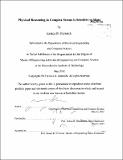Physical reasoning in complex scenes is sensitive to mass
Author(s)
Hamrick, Jessica B. (Jessica Blake Chandler)
DownloadFull printable version (7.883Mb)
Other Contributors
Massachusetts Institute of Technology. Dept. of Electrical Engineering and Computer Science.
Advisor
Joshua B. Tenenbaum.
Terms of use
Metadata
Show full item recordAbstract
Many human activities require precise judgments about the dynamics and physical properties - for example, mass - of multiple objects. Classic work suggests that people's intuitive models of physics in mass-sensitive situations are relatively poor and error-prone, based on highly simplified heuristics that apply only in special cases. These conclusions seem at odds with the breadth and sophistication of naive physical reasoning in real-world situations. Our work measures the boundaries of people's physical reasoning in mass-sensitive scenarios and tests the richness of intuitive physics knowledge in more complex scenes. We asked participants to make quantitative judgments about stability and other physical properties of virtual 3D towers composed of heavy and light blocks. We found their judgments correlated highly with a model observer that uses simulations based on realistic physical dynamics and sampling-based approximate probabilistic inference to efficiently and accurately estimate these properties. Several alternative heuristic accounts provide substantially worse fits. In a separate task, participants observed virtual 3D billiards-like movies and judged which balls were lighter. In contrast to the previous experiments, we found their judgments to be more consistent with simple, visual heuristics than a simulation-based model that updates its beliefs about mass in response to prediction errors. We conclude that rich internal physics models are likely to play a key role in guiding human common-sense reasoning in prediction-based tasks and emphasize the need for further investigation in inference-based tasks.
Description
Thesis (M. Eng. and S.B.)--Massachusetts Institute of Technology, Dept. of Electrical Engineering and Computer Science, 2012. Cataloged from PDF version of thesis. Includes bibliographical references (p. 57-58).
Date issued
2012Department
Massachusetts Institute of Technology. Department of Electrical Engineering and Computer SciencePublisher
Massachusetts Institute of Technology
Keywords
Electrical Engineering and Computer Science.